So. It turns out going to America to spend two months with your girlfriend is not especially conducive to visual novel liveblogging. Apologies for the delay everyone—but at least it’s not five years, hey…………………?
A few people dropped by to comment during the hiatus. First up we have Mads-in-Zero, who writes:
Oh right! There was something I wanted to say, now that I’ve caught up - I really love that this visual novel signals magic by using electronic music.
Episode 1, which is a major paschtiche of certain styles of detective fiction, (closed circle rich mansion, characters dropping one by one), maintains a consistant classical music flair throughout, they have so many violin pieces.
Until, suddenly, Maria reads out Beatrice’s letter, and the first really off-kilter song (Fishy Aroma) plays. It’s the first song a lot of players, myself included, really notice as standing out.
And then, when the murders start, we get the music playing over the body discovery, GoldenSlaughterer. It mixes Beatrice’s classical music leitmotif with Electronic Dance Music to create a song that signals the classical mystery tropes have been interrupted by a Witch.
(There’s another series of doujin VNs that use electronic music for a similar effect (signalling “magic”), the TYPE MOON series, particularly it’s second entry, Fate/Stay Night. Ryukishi is unabashedly a fan of those games.)
That’s really interesting! I hadn’t thought to actually break down what each leitmotif denotes, outside of the association between Beatrice and baroque harpsichords.
I’m not surprised Ryuukishi is a Type-Moon fan. Its shadow is long and ngl, Ryuukishi can bring that chuunibyou energy. I’m only really familiar with three of Fate’s storylines, the ones which Ufotable adapted into anime (Zero, Unlimited Blade Works and Heaven’s Feel)—but it definitely adds a dimension to the magic battles we’ve seen. The notion of reaching back into history and mythology to send out magical agents against an opponent is very Fate, indeed.
Last time, we continued to learn about Ange, who is at this point less of a deuteragonist and more of the new protagonist. We also learned about Maria, and how her lion Sakutarō became her very first furniture, extra special furniture no less.
The next chapter takes place in October, 1998—the same month as Ange’s apparent suicide attempt/ascension to witchdom. The camera navigates from the street outside to a fancy restaurant on a high floor of a building. An unknown person’s voice is telling a story.
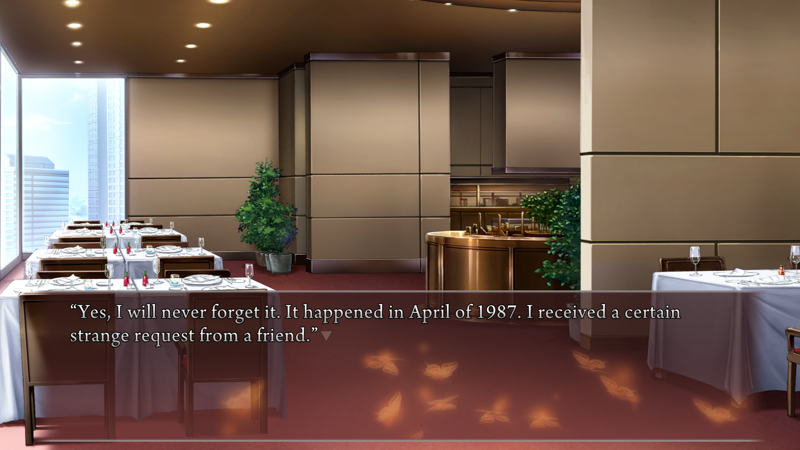
April, 1987, huh. We might fill in more events since the murders. Indeed: in 1987, it turns out Kinzo’s vast occult library was sold at auction. Ange’s interlocutor turns out to be a wizard from a local university.
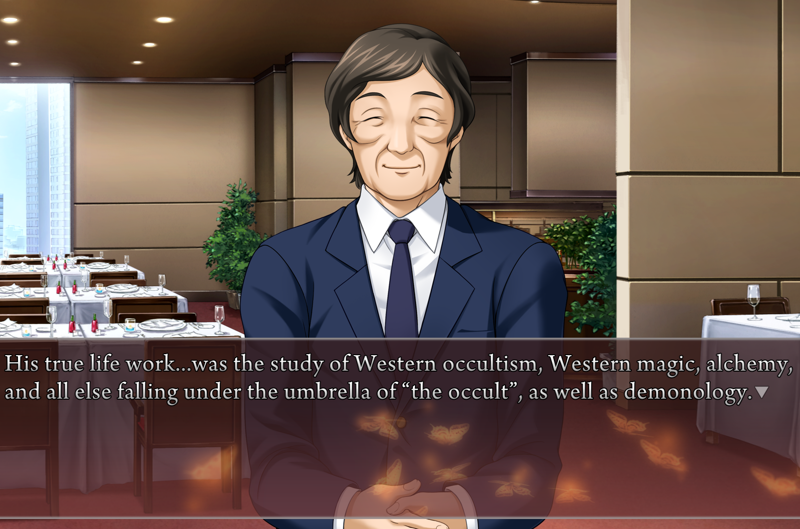
He’s got a pretty fascinating character design, with heavily indented cheeks that make his cheekbones kind of fold over the rest of his face. His hair makes me think of the Beatles, but I guess it’s just old person hair. This gives us his character screen, which is naturally on the Ange Side:
- Professor Ootsuki (大月教授)
-
A professor at a certain college, well-known as an authority on the study of Western folklore.
Also famous as a hobbyist researcher of the Rokkenjima Witch Legend and as one of the Witch Hunters.
The Witch Hunt is primarily focused on the straining of occult superstitions to explain the truth of the Rokkenjima crime rather than doing so scientifically, and its dilettantes and enthusiasts of the mystical primarily view it as a type of mental game.
Ah, so that’s what the Witch Hunt translation is named after.
We learn that Eva sold these books very soon after the murders—too soon for ‘the rest of the family to be legally declared dead in absentia, even given the extraordinary circumstances.’ So the bodies of the other Ushiromiyas were never found! That’s an interesting tidbit.
Eva, in the official narrative, escaped harm by hiding in Kuwadorian. She sold off Kinzo’s books because she couldn’t yet claim life insurance on the dead Ushiromiyas.
Ootsuki compares the public release of Kinzo’s library to the Dead Sea Scrolls, since they contained well-attested thousand-year-old documents which had until then never been found. The narration adds that in the eyes of ‘dilettantes’, it is thought that many important occult books, or the missing pages of Leonardo da Vinci’s notebooks, may be lurking in private collections.
The word ‘dilettante’ is a curious one here. I can’t look up the Japanese since there’s no VA for narration, but in English it’s a pretty negative term, referring to someone whose interest is casual dabbling. But I guess the wider public, whose point of view the narration assumes here, doesn’t know just how seriously Kinzo took the whole wizard thing.
Another tidbit: the accident likely destroyed even more valuable works. It’s sounding increasingly like Kinzo’s mansion was somehow blown up. In any case, Kinzo’s library brought a lot of public attention to Rokkenjima - probably the thing that made it a ‘jiken’ in the first place, and associated it definitively with witches. And this was further cemented when the message in a bottle containing Maria’s diary showed up.
Ootsuki mentions that in ‘famous foreign detective novels’, throwing a message in a bottle into the sea has become known as a ‘method of confessing the truth after one’s own death, like a time-delayed will’. What novels are these? The most famous must be And Then There Were None by Agatha Cristie, which uses it exactly as described. (Originally published under a much more racist title.) I can’t find any others what with the internet being SEOfucked to death.
So as for Maria’s letter, this made its way to a young fisherman on the neighbouring Shikinejima, who held onto it until the media storm. Could it be a forgery, then? Ange immediately asks this exact question, bless her. Ootsuki admits this is possible, and indeed, even though it had Maria’s signature, the handwriting was not hers. Well, well.
However, during the investigation, the cops found another message in a bottle. This was written in the same hand as the first bottle. The story they relate is as we’d expect: the Ushiromiyas getting ritually killed for the sake of Beatrice’s resurrection. Whoever wrote this was intimately familiar with Rokkenjima, which narrows it down to the cast we know, as well as the servants who weren’t on the island at the time of the murders.
Ootsuki has a noticeable habit of saying さようです, meaning “that’s right” (the translation puts it “Correct.” which matches his tone). I find this amusing since that is also how you would say “it’s Sayō”… ok, Sayo’s name doesn’t have a long o, but. Clearly this is a clue that she is the one that dunnit, eh?
Anyway, the two accounts of the murders in the fisherman’s bottle and the police’s bottle are inconsistent. Presumably, one is the events of Episode 1, and the other the events of Episode 2?
Ootsuki goes on to enthusiastically tell Ange about the Rokkenjima Witch Hunt. He even went to a conference on the ten year anniversary of the murders to ‘represent Japan’. This conference somehow even had middle schoolers attending. This feels kind of like an analogy for the fans reading Umineko, huh?
Ange tunes him out. She’s found one piece of information—that the author was almost certainly not Maria. She reasons that given the vast amount of writing involved, these two stories were most likely written before the murders happened. Seems hard to argue. This seems like evidence the murders were premeditated.
Because Eva dies in both stories—so this is presumably chapters 1 and 2, indeed—Ange further concludes that Eva was likely an intended victim of the culprit, and the intended spree of murders had fallen short.
As a parting word, Ange asks Ootsuki what interested him in demonology. His answer:
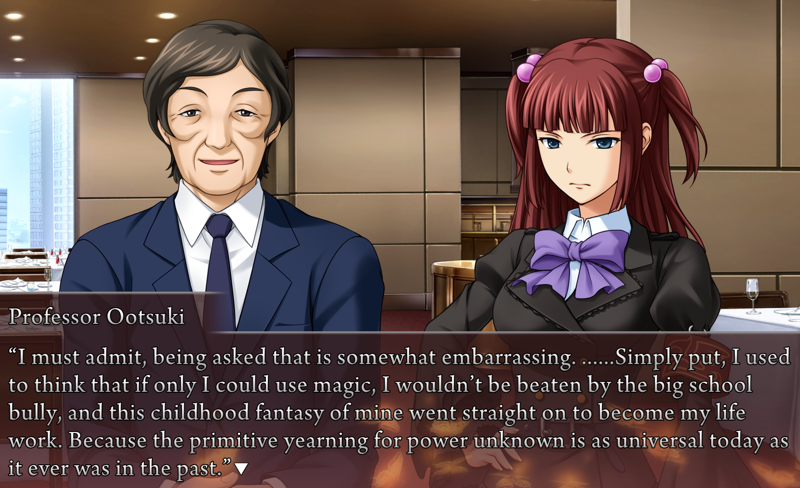
Very blatantly paralleling Ange and Marias’ circumstances for taking an interest in magic.
Ange: ………If I told you that actually, I am a witch, would you believe it?
Ootsuki: Hahahaha. It’s my pet theory from my few experiences with women that they are all witches.
Fascinating. That is perhaps the worst possible answer to that question.
Ange whips out Maria’s diary, and shows him a page with a letter from Beatrice to Maria. Ootsuki, who knows the handwriting in the bottles intimately, confirms it is the same hand. Without answering his questions, Ange throws him a wad of cash and leaves.
Such swag.
Ange: ……And this book is the key to opening it [the ‘cat box’]. It’s too good for you. Well then. <Goodbye, gentlemen>. <Have a nice day>.
I love the way she uses English lmao.
Turns out she was playing the role of a Sumadera, thus evading the ambush of the real Sumaderas. Very clever. We cut to the actual Sumadera Kasumi, who’s rather peeved by all this.
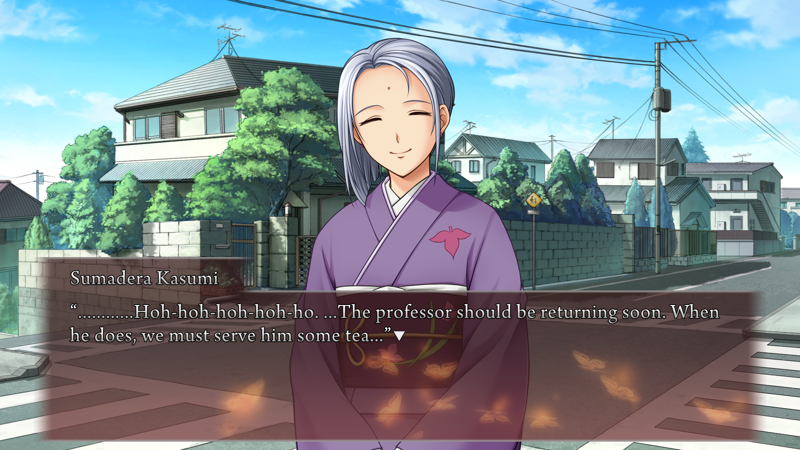
Twist: Kasumi isn’t actually using ‘serve tea’ as a euphemism for torturing people. She just serves such nice tea that people do what she wants.
She follows this up, naturally, with an ohohojosama laugh.
Black text then intervenes on the screen. It says…
I’ll teach you.
About my Magic of Origins.\No, I taught you before, right?
And you used to be able to use it.
Did you forget……?
This text—presumably Maria, given the Magic of Origins reference—continues to say that Ange had her name entered into this Mariage Sorcière deal. Did you know, in Ubuntu using a British keyboard layout, you can type a grave accent with compose-#? I think I’m going to be doing that a lot…
We cut to a comfy hotel room where Ange is trying to drift off with Maria’s diary. She recalls how she “used to be one of the witches”; Maria manifests in her new outfit. Maria says she could remind Ange of magic, if she wanted; Ange says she has indeed started wanting.
Maria warns that in Ange’s state, voices, sounds and even presence of people will interfere. All the things that could embarassment enough to disturb a personal ritual or game of imagination? Perhaps so.
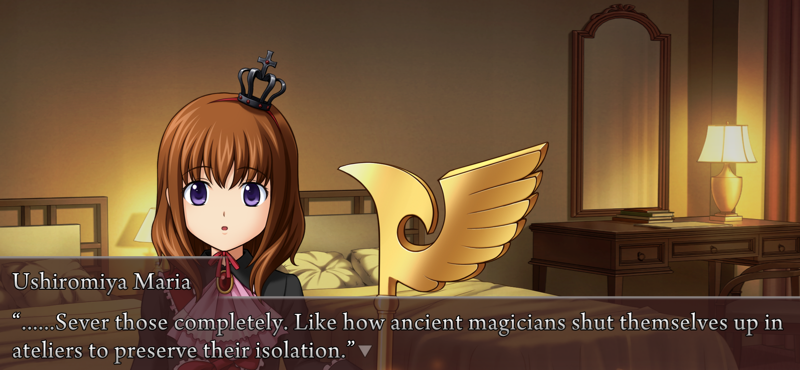
The word atelier (アトリエ) here is interesting to me. It refers to an old mode of teaching art, with a guild-like master-journeyman-apprentice system. For some reason, in certain Japanese fiction, the word seems to have instead become associated with a wizard or alchemist’s workshop, as in the Atelier series of JRPGs, which began in 1997. The manga Witch Hat Atelier, which began in 2016, unites the two by having a magic system that is based around drawing, so its ‘atelier’ is a place where young people learn to draw and an alchemist’s workshop.
Anyway, I don’t really have any further observations to make, just found it interesting to find another instance of the atelier-wizard connection.
Maria explains that Ange will need a vessel for this to work at all, and further warns Ange that training in magic at her age will be slow going. Something best started as a child. Ange herself makes the connection to music training. For this reason, Ange can’t hope to enchant her hair ornaments. (From a rhetorical perspective, introducing rules and limitations to follow makes magic more plausible.)
Instead, she searches her bag and finds… one of the Seven Stakes of Purgatory, picked up from Rokkenjima some time in the past! Damn, Ange, you’ve been carrying that around this whole time? That’s dangerous! …Maria says the stake is currently masterless, and should be within Ange’s ability to summon. Which sister will it be? Let’s roll the dice…
Before that, a new rule about How Magic Works. Conveniently, Maria, as a witch of the Mariage Sorcière alliance, has the right to use Beatrice’s furniture. As does Ange. Conveniently, Maria wrote down the instructions for summoning the stakes in a grimoire. Conveniently, Ange has it on her person.
This feels like one of those Blades in the Dark-descendent TTRPGs, where you can spend a resource to have conveniently packed something in advance.
Our stake this time is Mammon (Greed). Maria is quick to inform us of the positive side of greed…
Maria: Greed (強欲) also controls aspirations, the desire to improve oneself, and the strength to live. It definitely doesn’t only mean bad things. ……She’s rude, but she’s a girl who tries really hard.
Ange: You could say that without desire, there’s no reason to live.
Sure, if you like. Proper little egoists right here. (The connotation of the word 強欲 seems to be just as negative in Japanese.)
More magic rules: knowledge helps. Autism + special interest in magic must be a huge bonus then, huh.
Grimoires, the two girls agree, are much more interesting than mere novels to based magic-enjoyers such as themselves. Yeah, too right! For that reason I’m abandoning my Umineko liveblog and commencing a liveblog of the tenth-century grimoire Ghâyat al-Hakîm—
More data: sacrificial tools like the Stakes are ‘even below weapons’ on the ranking of furniture (presumably the ‘weapons’ being the Chiesters); Ange is not presently protected by the alliance (why…). She takes Maria’s amulet.
Here’s Ange’s invocation, much shorter than Beatrice’s ones. She says it almost in a bored voice.
さあ、さあ、お出でなさい。罪を許しなさい。煉獄の七杭のひとつ。強欲のマモン。
Come, arise. Forgive the sin. …One of the Seven Stakes of Purgatory. Mammon the Covetous.
She repeats this, with an additional line (‘show yourself to me’), while projecting her mind into some kind of void space lit from below; there’s a lot of wind; Mammon wakes up and goes for her but, hey, Maria’s charm. Unable to puncture the charm, Mammon assumes human form, in her familiar costume. Ange is dismissive of her uniform - big talk for a girl with nearly exactly the same amount of zettai ryōiki, but [looks at designs again] ok yeah sure fair.
Anyway, we now have all seven Sisters on the Ange Side character screen. The descriptions haven’t changed from previous episodes.
Mammon is not impressed by Ange’s power, but a word from Maria gets her to play along. She’s eager to sacrifice someone, but Ange only wants to talk, like in old times, when she used to cheerfully hang out with the Sisters.
I have to wonder… why would you ever stop doing magic, if magic is unambiguously real?
Mammon asks Ange to user her stake to summon the other six sisters to help with the ‘entertain Ange’ mission. Both because greed is her thing, and because, Ange muses…
………Bliss for furniture is when it is used. Being used, no matter how roughly, is furniture’s joy.
Not only that, but no matter how much care you might treat them with, if they are not given a job, that would give them great anguish.
I dare say Kanon and Sayo may have a thing or two to say about that.
Anyway, despite the considerable strain, Ange goes ahead and tries to imagine the other six sisters into existence from memory.
So, it seems like the qualifications of a witch are similar to those of a storyteller. The GM of a roleplaying game, perhaps. To imagine into existence a number of individuals, keep track of them, and imbue them with distinctive characterisations. And from that perspective, doing seven at once, even one-dimensional characters like the Sisters, is pretty hard going!
The older sisters start arguing with Mammon, agreeing with Maria that they really shouldn’t pressure Ange into summoning all seven. Which seems to be correct: after doing five (up to Satan), Ange collapses into bed and passes out. Damn, I gotta learn that trick for beating insomnia.
Entering a dream, Ange-the-witch is welcomed back by Maria and Sakutarō…
And that’s a wrap on this chapter! I’m sorry it’s taken basically all of November to write in the end.
OK, thoughts on this chapter:
Bit by bit, we’re building up a new little castle of rules for this chapter. How magic works, etc. etc. It’s funny that tulpamancy seems to be the core of it. We’re also getting a drip feed of new ‘outside’ details about the Rokkenjima incident. The in-universe existence of games 1 and 2 (presumably not including all the ‘outside’ arguments between Battler and Beatrice) is notable.
But how does all this stuff about ‘furniture’ bear on the original mystery? Well…
So it’s time to advance a really crazy theory.
Battler Ushiromiya is not real.
Not just in that he’s a fictional character (duh)—I mean Battler Ushiromiya is ‘furniture’.
In other words, Battler is a tulpa or advanced imaginary friend, created by the mysterious author of the two ‘diaries’ to act as an interlocutor. By arguing in their head with ‘Battler’, this author—who I’ll call Beatrice, for now, since that’s her nom de plume—comes up with material to fill out these novelisations of ways the murders could play out.
This explains things like, why the hell has Battler got a weird name like ‘Battler’? Because his entire purpose of existence is to ‘battle’ with the scenarios concocted by Beatrice.
It’s worth noting that like, in the previous episodes, Battler never seems to do very much. Well, OK, that’s not entirely fair. He argues with the other characters about whodunnit, he emotes (a lot!), he defuses some tense situations. But when it comes to learning magic, or picking up a gun and going off to fight the perpetrator, it’s never Battler. It can’t be, because Battler is the primary viewpoint character—he has to live long enough to see the story to the end, and everyone who fights the witch dies. And, he can’t very well argue about whether magic is real if he sees it happen, first-hand. So Battler must always be away from the real action.
We could further speculate that none of the Ushiromiya cousins are real, except Ange, but that might be a bridge too far.
The obvious rejoinder to this is that, in the Ange side, Ange seems to fully believe Battler is real. Ushiromiya George’s existence is widely discussed by the wider world. However, Ange’s main record of what happened on the island is… Maria’s ‘diary’. Eva won’t talk. So is it possible that an extra Ushiromiya sibling has been snuck in to the historical record somehow?
Alternatively, the ‘Battler’ of our acquaintance may simply not resemble the real man. But that doesn’t explain his silly name, so I kind of want to think he doesn’t exist at all.
Is this too much of a crackpot theory? Well, let’s find out. <See you next time>.
Comments
Renasimp
It’s the other way around surprisingly. Witchhunt in the VN is named after the translation group.
https://witch-hunt.com/letter.html
Gabriulio
One interesting tidbit is that The Witch Hunt translation team is not named after the in-universe group, it’s the other way around.
While the visual novel market has grown by leaps and bounds as years passed, it is still very niche nowadays, let alone back when Umineko first released. The few visual novels that had translations were, 99% of the time, those that had anime adaptations.
The cycle went: visual novel gets released in Japan, but virtually no one in the English-speaking world hears or cares about it -> it becomes popular enough to gain an anime adaptation -> people in the English-speaking world watch the anime and think it’s neat -> there’s a very small but non-zero chance of a group of fans banding together to translate the source material -> there’s an even smaller chance of the translation actually getting finished.
Higurashi, Ryuukishi’s previous work, fit all aspects of the cycle… but Umineko was different. Umineko wasn’t unknown. Higurashi had an established fanbase thanks to its anime adaptation, so Umineko wasn’t just “one of the thousand new visual novel released every year,” it was “the next work of the Higurashi creator!”. As such, there was interest in translating it even before EP1 first released, and a team of fans did just that.
That translation team called themselves The Witch Hunt.
The in-universe Witch Hunt organization isn’t named like that due to coincidence, it was a deliberate homage to the translation team. Ryuukishi was well aware of the team’s existence, and he was in fact honored that people were so interested in his work that they were translating it into an entirely different language. He even sent a letter to The Witch Hunt thanking them for their efforts, which can be found on their website.
Fan
Actually, them being called Witch Hunters(in the original Japanese) is based on this translation team, which started working before ep4’s release! If you know Rokkenjima.org, their podcast for episode 8 has a member of the group on to talk about this! I wouldn’t recommend the website before finishing it yourself though, or at least making a more finalized theory then I’ve seen.